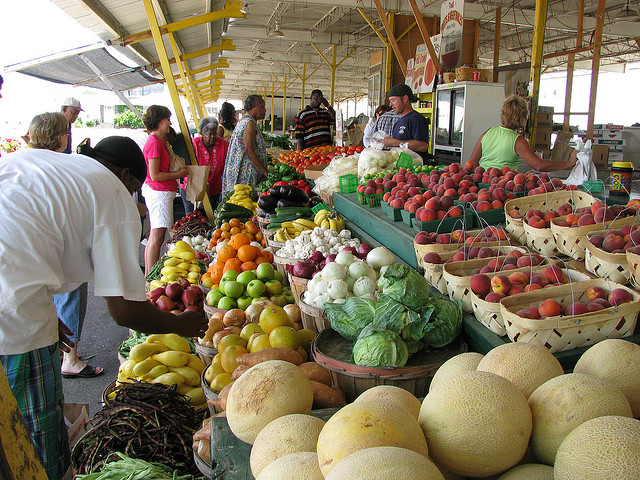
A USDA grant will increase access to farmers markets for low-income Americans. Photo by Natalie Maynor via Flickr
WASHINGTON — Farmers markets are a great way to find reasonably priced fresh produce, but many only accept cash or checks – a big problem for low-income shoppers using food stamps. Now USDA is trying to change that.
Agriculture Deputy Secretary Kathleen Merrigan on Wednesday announced a $4 million grant for states to help implement wireless technology that will allow more farmers markets to accept Supplemental Nutrition Assistance Program benefits, or food stamps.
Markets need a wireless Internet or telephone landline connection in order to accept Electronic Benefit Transfer payments, which is not always available for outdoor markets in parks or parking lots. And small markets often can’t afford to set up the technology.
“I had to convince my directors that it was going to be worth the additional cost,” said Jeff Dabbelt of Lexington Farmers Market in Kentucky.
Dabbelt set up a point-of-sale machine on his own two years ago in order to accept card payments, which he said brought in $14,000 from EBT cards last year.
“There can be some inherent business that comes to your table just by the machine being there.”
Though he had to go through the bureaucratic channels on his own to set up the machine, he was happy to learn that the federal government will offer some assistance to smaller markets.
“I’m all about it. It’s almost a necessity, if not outright, 100 percent necessary,” Dabbelt said. “That assistance would be invaluable, all across the country. No doubt.”
Health experts say the lack of affordable healthy food in low-income communities is directly related to obesity in that population.
“The retail food environment is not the same in every neighborhood,” Dr. Brian Smedley of the Health Policy Institute at the Joint Center for Political and Economic Studies said at a Centers for Disease Control obesity summit this week.
“The higher the level of poverty concentration, the more difficult it is to access grocery stores or super markets selling healthy foods. We have a food environment that is overrun with fast food outlets and convenience stores, all selling food that is highly processed.”
According to a federal study released during the CDC’s Weight of the Nation, this lack of access to healthy foods directly contributes to the United States’ high obesity rates.
“As the trends show, people have a very tough time achieving healthy weights when inactive lifestyles are the norm and inexpensive, high-calorie foods and drinks are readily available 24 hours a day,” said former Agriculture Secretary Dan Glickman, chair of the report committee.
Some cities have taken the matter of improving food environments for low-income residents into their own hands.
In 2006, while working on zoning laws for community gardens, Cleveland Councilman Joe Cimperman discovered that only half of his city’s farmers markets accepted SNAP benefits.
“I found that to be very sinful. I also found it to be very stupid,” he said. “I say that with a little bit of a hammer, but there’s also a bit of love.”
Cimperman and his colleagues passed legislation mandating that any markets using public land, including sidewalks and streets, must accept EBT payments.
“Today, every single farmers market in the city of Cleveland does,” he said.
Erin Gillespie, a representative for Florida’s Department of Children and Families, the agency responsible for SNAP accounts in that state, pointed out an additional benefit of federal funding for farmers markets.
“Obviously some of these farmers markets are small and probably don’t have a lot of income to spend on technology to accept EBT cards,” Gillespie said. “It will help them stay in business and for people who need the assistance, it would give them access to healthy food that they may not have access to.”
- More than 46 million Americans receive SNAP benefits through the federal government
- There are 7,100 USDA-registered farmers markets.
- 1,500 of those markets accept EBT cards.
- Each state’s portion of the grant is determined by federal formula; Florida, for example, will receive $78,749.
- SNAP benefits use at farmers markets has quadrupled since 2008.
- 100 percent of Cleveland farmers markets accept EBT cards, following legislation requiring all markets using public land to accept them.
